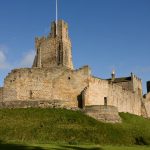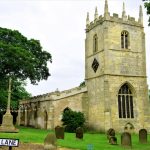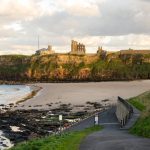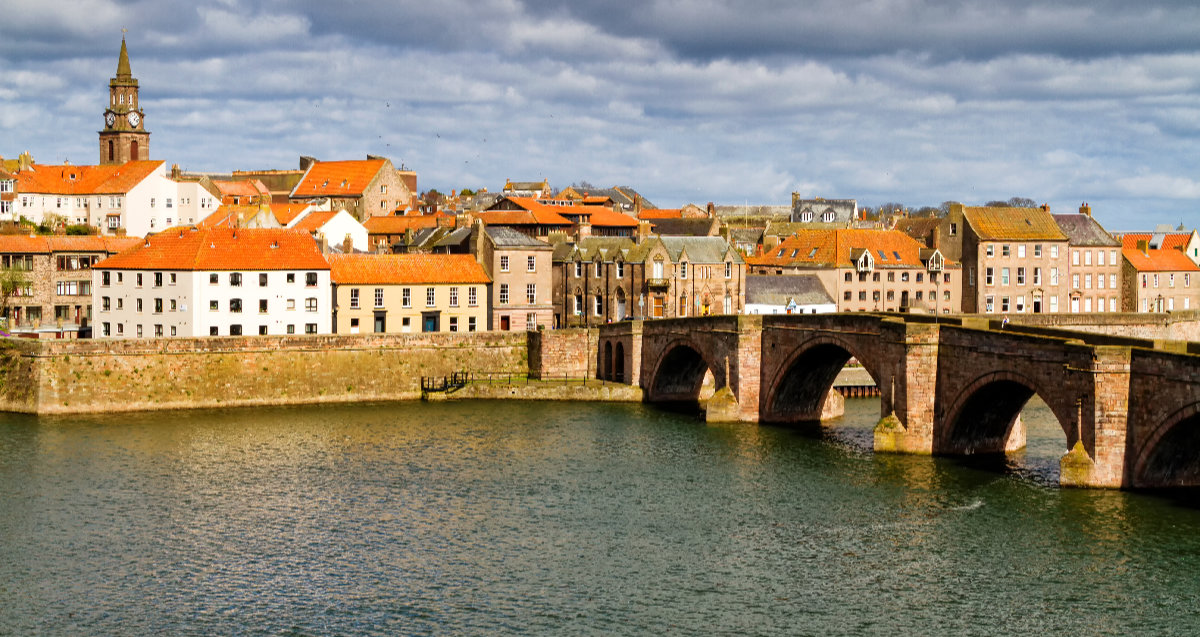
Berwick-upon-Tweed – Scotland or England?
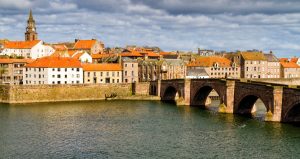
Image: Milosz Maslanka/Shutterstock.com
To answer the above question, Berwick Upon Tweed or Berwick as it is normally referred to is now firmly based in England, although it is only 2 1/2 miles south of the Border and is the most northerly town in England. It is located on the banks of the famous Salmon fishing river the Tweed as its name suggests and nowadays it spans the river as it encompasses Tweedmouth on the south bank.
This was not the case though until 1707 when the Act of the Union ratified Berwick’s status as English, and at one time it was even a “county corporate” (self-governing and effectively independent of either country). To confuse matters their local Football & Rugby teams even play in Scotland, although at the time of writing Berwick FC have they have lost their Scottish League place.
Anyway, as you can imagine this is a place steeped in history remaining one of the most fortified towns of Europe so well worth a visit, and if this is not enough to pique your interest, there is that matter of the town theoretically being at war with Russia for many years… Bet that got your attention!
So without any further digression here is our quick guide to this quaint, now English, market town…
Early History
Berwick lies to the north of Hadrian’s wall so if it existed as a settlement in Roman times at that time it was Scottish. Subsequently, it is thought that the region was inhabited by the Anglo-Saxon’s and eventually became part of the Anglian Kingdom of Bernicia the predecessor to the then mighty Kingdom of Northumbria which in the 7th Century ranged to the north of Edinburgh. Given its location by the coast and on a major river it would likely have some strategic importance and some form of settlement probably existed.
Berwick Is English!
Possession wise things remained pretty much as they were until 946 when Eadred took charge forming the Kingdom of England. This was a bit of a troubled time for the region with amongst others Eric Bloodaxe trying to lay claim to the region. His attempt was brutally suppressed and around this time the town of Berwick became established as a strategic asset. It would remain part of the Earldom of Northumbria until control passed to the Scots in 1018.
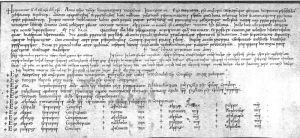
Charter S 512 of Eadred dated 948 dealing with his new powers. Anonymous Unknown author / Public domain
Now Berwick is Scottish Again!
Things took a turn for the worse, well as far as the English were concerned following the Battle of Carham in 1018 when the combined forces of Malcolm II and Owen the Bald defeated the earl of Northumbria’s army and in doing so claimed the lands north of the Tweed for Scotland. The Town of Berwick was now firmly on the (Scottish) map or should we say South Berwick as it was named to avoid confusion with the existing Town of North Berwick on the East Lothian Coast. Around 100 years later, David I of Scotland made Berwick a royal burgh and it even got its own mint 1153.
Back and Forth
Sadly thereafter this increased wealth and strategic location ensured that peace was never long-lasting for the Town. William I of Scotland got the back and forth ball rolling with a disastrous incursion into Northern England in 1173 & 74 which led to defeat and Berwick becoming English again. This only lasted a few years though as Richard I sold it back to William I to help finance his Crusade!
Then in 1294, The Anglo-French war kicked off and with Scotland being allied with France this was a disaster for Berwick, which once again saw its self embroiled in violence. In what was probably retaliation for John Balliol’s sacking of Carlisle, Edward I captured Berwick, taking the town on 30th March 1296 and in doing so massacred a huge chunk of the civilian population.
The next change of ownership would occur largely thanks to Edward II’s defeat at the Battle of Bannockburn which led to Scottish incursions south of the border and in April 1318 Berwick was Scottish again. England retook Berwick in the aftermath of the Battle of Halidon Hill in 1333 and English it would remain until 1461 when it once again became a pawn in greater struggles being ceded back to the Scots by Margaret of Anjou in return for supporting the Yorkists during the Wars of the Roses.
In 1482 it was English again when Richard, Duke of Gloucester (later Richard III) retook the town and so it continued until in 1551 the town was made a self-governing county corporate! In the preceding 400 years or so it must have changed hands a dozen times!
Despite it being self-governing (or maybe because of this) Queen Elizabeth I of England reputedly spent vast sums building its famed gun ramparts & fortifications which remain to this day, and in 1587 James VI then of Scotland (subsequently James I of England) invested considerable sums in giving Berwick one of the better medieval hospitals. It even had its own formidable garrison, however, this was largely disbanded when on the orders of James following the Union of The Crowns in 1603.
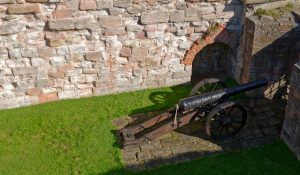
Image: Phil Nixon/Shutterstock.com
Berwick Is British!
In 1707, the Acts of Union between England and Scotland largely ended the contention about which of the countries Berwick belonged to, although it still technically remained a county corporate until 1885. However, since 1746 Berwick has been covered by the laws of England and Wales thanks to the since repealed Wales and Berwick Act. Finally in 1885 Berwick’s 334-year tenure in no man’s land ended when it was formally amalgamated into Northumberland for Parliamentary purposes and the number of MPs the town had was reduced from two to one.
Today
The Borough of Berwick-upon-Tweed was abolished in 2009 and the town now falls under Northumberland County Council drawing a line under what must be one of the most convoluted histories ever and Berwick is no longer the economic powerhouse of old. Back in the 1300s, it was one of the most populous towns in Scotland however at the 2011 census and its population was only 12,043, well below what some historians estimate lost their lives in the 1296 Berwick massacre.
Economy wise the Town is heavily service industry biased meaning there are plenty of shops and places to eat available. The once important port is now located to the south of the town in Tweedmouth and mainly handles cargo, while agriculture and Salmon fishing still have some importance.
Anyway, that concludes our potted history lesson so now on to a few interesting facts (oh dear not more history we hear you cry!!)
Not A Lot Of People Know That…
In 1292 John Balliol was pronounced King of Scotland in the Great Hall of Berwick Castle; (on 17 November 1292).
After he was executed By Edward I in 1305 one of William Wallace’s arms was put on display in the Town. A grizzly reminder to those then north of the Border to behave themselves.
It didn’t work though as despite Berwick supplying some 25,000 for the army of Edward II they still lost at the Battle of Bannockburn in 1314.
Berwick Bridge as it stands today took 14 years to fully complete and is thought to be its 8th incarnation
Berwicks Holy Trinity Church is the most northerly parish church in England and has no spire due to Oliver Cromwell’s puritanical rule which no doubt thought spires too ostentatious. Well, he did ban Christmas after all (Ba Humbug)!
When the Treaty of Paris – ending the Crimean War1856 Berwick being a county corporate was left out of the document. Hence technically the town of Berwick was still at war with Russia. However, since they were not mentioned in the declaration of war either it is debatable if they ever joined it. Whatever it makes an interesting story.
British Author Rachel Joyce based much of her rather entertaining 2014 novel The Love Song of Miss Queenie Hennessy in Berwick. If you like your romantic fiction with a twist give this a read.
Finally, Berwick Rangers Football Club is famed for pulling off one of the biggest ever shocks in World Football. More on this below.
Twin Towns
It is not too surprising that Berwick has joined in the town twinning craze and their efforts span three continents including their namesake in the USA. The Five they are conjoined with are:
Casey – Australia
Haan – Germany
Sarpsborg – Norway
Trzcianka – Poland
Berwick – Pennsylvania USA
Famous Locals
For a small town, Berwick has produced a few famous people (mainly footballers) we are conscious of this being a five-minute guide so here are three:
Trevor Stephen – who may never have pulled on a Berwick FC shirt but did win two English League titles with Everton, one French Title with Olympique de Marseille and six Scottish Premierships with Glasgow Rangers in his illustrious career!
Sticking with Football we have Lucy Bronze who has similarly won a plethora of honours at the highest level of Women’s Football including the Women’s Champions League in 2018 & 2019 with French side Olympique Lyon. Her pinnacle though is currently being part of the England Women’s National Team which finished 4th at the 2019 Women’s World Cup Finals (she even managed a goal!).

Lucy Bronze In Action for England at The 2019 World Cup. Image: Jose Breton- Pics Action/Shutterstock.com
Finally less well known but undoubtedly as, if not more important we have James Redpath who emigrated to America around 1849 and went on to become a successful journalist and anti-slavery activist.
Not bad for a small town that couldn’t decide if was English or Scottish for a few hundred years.
Sport
With the town producing two such famous footballers it’s only fitting, we move on to the Towns sporting clubs starting with Football.
Berwick Rangers FC is the towns main club dating back to 1881. In their early days, they played in various English & Scottish Regional leagues before being elected to the Scottish League proper in 1951-52; the Scottish League Division C (North & East). They continued to play there until it was scrapped in 1955 and they were promoted to the newly expanded Scottish League Division Two.
Have they Won Anything I hear you ask, well…
Before they joined the Scottish league they did win the Scottish Border League in 1898-99 and as a league club, they won the Scottish League Division Two in 1978-79 and Division Three in 2006-07. However, their greatest success was undoubtedly their Scottish Cup giant-killing efforts of 1966-67, which will forever remain one of footballs biggest upsets.
In that game, Berwick FC managed to beat the mighty Glasgow Rangers 1-0 in front of a record attendance of 13,365 (more than the current population!). Sadly their heroic efforts that year ended with a narrow 1-0 loss away to Hibernian in front of over 30,000 fans.
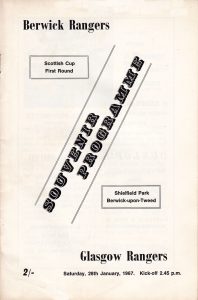
Their home stadium is Shielfield Park and the club currently plays in the Lowland League, the fifth tier of the Scottish Football League system. The ground has a 4000+ capacity so if you decide to take in a game you should be able to pay at the turnstile (although we would book a ticket as a memento).
Tweedmouth Rangers Football Club
The towns other team is Tweedmouth Rangers Football Club who have played in the East of Scotland Football League since 2016. Prior to this, they were members of the now-defunct North Northumberland League in England, which Berwick actually won back in the 19th Century. Their home ground is Old Shielfield Park, which the club uses under an agreement with the Berwick Rangers supporters club.
The town also has a Rugby Union side, Berwick RFC who play in Scottish Rugby Union’s East Regional League Division 1.
Speedway has taken place in Berwick in two separate eras. The sport was introduced to Shielfield Park in May 1968. A dispute between the speedway club and the stadium owners ended the first spell. The sport returned to Shielfield Park in the mid-1990s. The lack of a venue in the town saw the team move to a rural location called Berrington Lough. The team, known as the Bandits, have raced at all levels from First Division to Conference League (first to third levels).
Pub Quiz Fact:
Berwick Rangers and Berwick RFC are unique in being England based teams that play in the Scottish Leagues.
Things To Do & See
Not surprisingly there are a few nice buildings and constructions worth seeing. here are a few to whet your appetite:
Berwick Castle
Sadly now in ruins, you can still visit the remaining part.
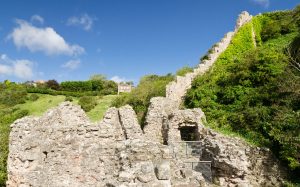
Image Dave Head/Shutterstock.com
Berwick Ramparts
Berwick’s town walls and ramparts are one of the worlds best-preserved examples of fortified town defences remaining in Britain. They were so good in their day that they largely made the Castle redundant. They are Grade 1 listed so should be around for many years to come.
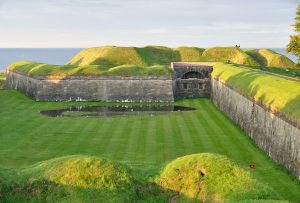
The Royal Border Bridge
This impressive civil engineering feat was built between 1847 & 1850 and is 720-yard-long! Today it supports the main East Coast railway line over the River Tweed and is also popular with wildfowl as can be seen in the photo below!
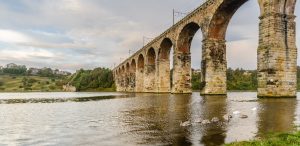
Image: Dave Head/Shutterstock.com
Holy Trinity Church
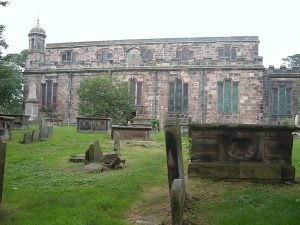
Holy Trinity Church With No Tower or Bell. Image: James@hopgrove / Public domain
This is one of only a handful built during the Commonwealth era marked by Oliver Cromwell’s reign. It was originally built in a modest style in keeping with Cromwellian views however it has been augmented since, including having an Organ installed in 1773. Still no bell tower though, so on Sunday the ones in the Townhall are rung instead. Speaking of Town Hall…
Berwick Town Hall
The Town Hall and in particular its 153-foot tall spire somewhat dominates the Berwick skyline is centrally placed and is well worth a visit. Parts of it served as a Gaol until 1849 and there are tours available. There is also a nice cafe attaching if you fancy a cuppa afterwards.
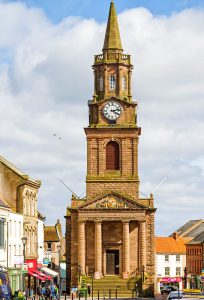
Image: Milosz Maslanka/Shutterstock.com
The Bells In Full Chime
If you are a bit of a Campanology fan or just want to see the town hall bells in action we have added a nice video below ( see we think of everything here).
Golf Anyone?
For the golf fanatic or even the casual player, there is a very scenic course at Magdalene Fields which is not only the last golf course in England but is only about five minutes from the town. So no excuse if you want a quick 18 holes.
Fancy a Walk?
If it’s a nice day (or you have a good brolly) then there are a couple of things you need to do when in the town. the first is:
Walk the Lowry Trail.
Want to walk in the footsteps of a famous artist? Then it could be your lucky day as Mr Matchstick Men & Matchstick Cats & Dogs himself L.S.Lowry was a huge fan of the town often holidaying here(bet you have the song running through your mind right now). Over 20 of his paintings, as well as several sketches, are based on Berwick.
Sadly none are on permanent display in the town, however, they do pay homage to him with a number of strategically placed panels that form a trail that will take you across the Tweed and into both Spittal and Tweedmouth. You can pick up a guide at the Tourist Information centre. Allow a good three hours to complete it.
Take a stroll in the park.
If you can’t commit three hours to the above then take in Castle Vale Park which is a sight to behold incorporating riverside views with planted borders and even a Lilypond. There is also plenty of opportunities to spot the local wildlife and if you are really energetic there is even an orienteering course which is free to use.
Getting To Berwick
Ok now we know how desperate you are to visit the town so here are the easiest ways to get here:
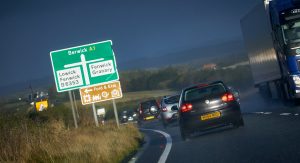
Berwick is on the A1 which is quite a busy road.
Image: Duncan Andison/Shutterstock.com
Road
As shown above, Berwick is pretty close to the A1, which is the main east coast road on the mainland, linking London to Edinburgh. At around 410 miles long its Britain’s answer to Route 66!
Air Links
Newcastle International Airport is your best bet, although you could also fly into Edinburgh which is a similar travel time by train and there is a frequent tram service linking the airport with the main railway stations in the city.
Train Services
Berwick station is located on the main East Coast Line which means you can literally hop on a train at London Kings Cross and get there without having to change trains at all. It’s a very scenic route so the near four-hour journey shouldn’t be seen as a chore. Similarly, it is only a 45-minute ride to Edinburgh (again direct) so for a sightseeing tour of the UK, there is really no excuse for not putting Berwick on the itinerary. It is also directly linked to Newcastle Station which offers good links to the west of the country.
Public Transport
The town is fairly well served by busses with services running to Glasgow, Edinburgh and Newcastle fairly regularly. Berwick, itself is fairly compact so you won’t really need to worry too much about using the in-town services.
Boat
If you really wanted to you could sail up the coast and moor at the harbour. However, We would strongly suggest taking one of the above for ease.
Where to stay?
There is no shortage of accommodation in Berwick (assuming they are not playing either Celtic or Rangers in the Scottish Cup the weekend you are visiting) and there is something to suit all budgets. At the higher end, there are some nice hotels including some quite close to the railway station, while for those more budget-conscious there are some cosy guesthouses and of course both a Premier Inn and a Travel Lodge.
It even has a very highly rated Youth Hostel which contrary to what the name suggests is not just for backpacking teenagers. There are a small number of private rooms which would suit families – however, you would probably need to book quite a bit in advance to get one.
If self-catering is more your thing then you might want to check out Airbnb which at the time of writing had a good range of cottages and flats available both in the town its self and also in the surrounding area.
Thinking of Moving Here?
Given what you have seen in the video above and read it may come as a surprise to hear that property prices in Berwick are below the county average. According to Zoopla in June 2020 the average property price in the town was estimated at £189,535 which is quite a bit below their quoted Northumbrian average of £198,000. Of course, this will incorporate a fairly dramatic spread in prices, however, it does makes it one of the cheaper seaside towns to buy in, in England.
Well, that just about brings us to the end of the Five Minute Spare overview of this historic town, which should be on everyone’s to visit at least once list. Before you go don’t forget to join the site so we can keep in touch and once you have done that try one of our quizzes – there is even a Berwick one to see if you took any of the above in!
